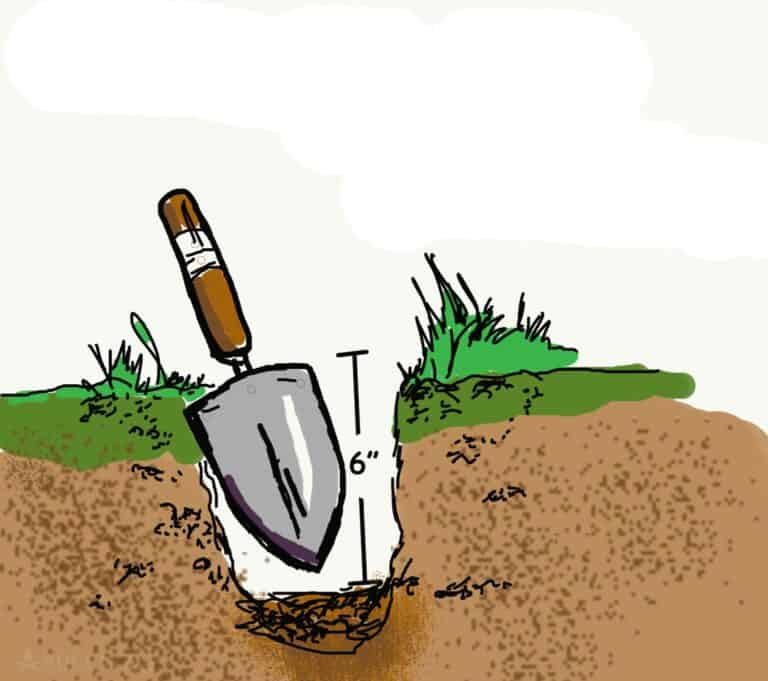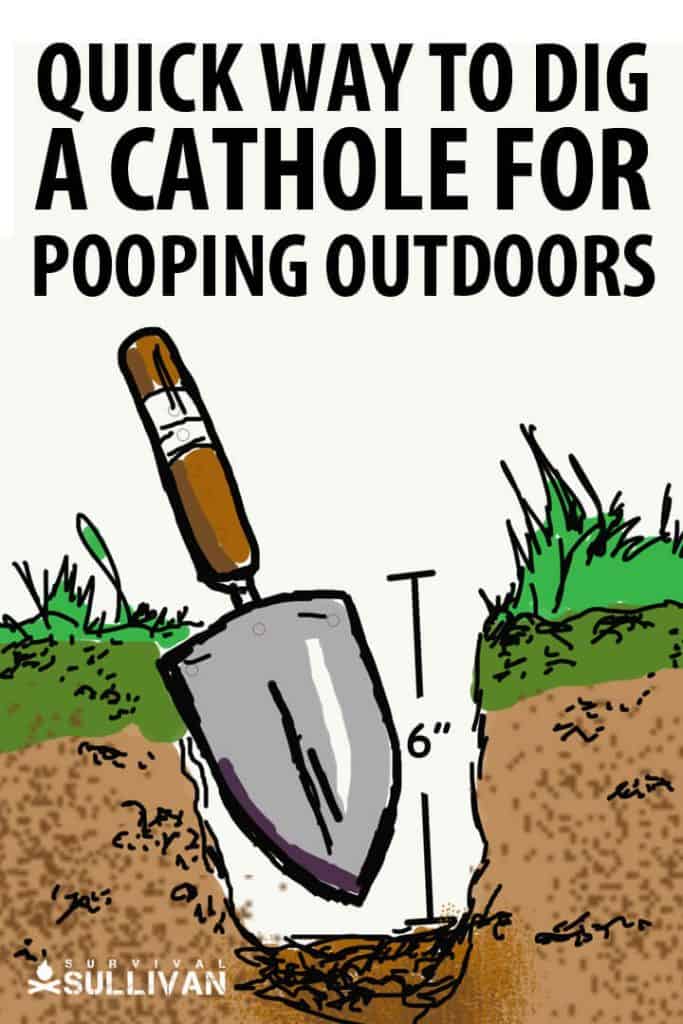Let’s face it, everyone eventually has to “go” during a hike or camping situation. If you’re lucky, there will be toilet facilities nearby.
But if in fact, you are on a hiking or camping trip where there isn’t a toilet facility nearby and have to “go”, don’t despair. Or if you find yourself in a bug out situation with no available facilities, just dig a cathole.

If you aren’t familiar with this term, it’s basically a pit that you dig in the woods or other outdoor location so that you can bury your urine and/or feces.
The main purpose of a cathole is to keep the feces under cover so that other people don’t step in it, animals don’t dig it up, and the odor is contained until it can biodegrade.
Table of Contents
Why is it Called a Cathole?
Have you ever seen how a cat will dig and scratch at the ground or in their litter box before squatting to do its business? You notice how they then sweep the soil or litter over the hole to cover it up when they are done?
It’s the same thing here. You want to dig a hole for your own poop or pee, and then cover it up when you’re finished.
Why Should You Dig a Cathole?
You might wonder, since you were out in the middle of nowhere far away from civilization, what is the point in digging a cat hole at all?
After all, all the other animals in the woods, on the plains or in the desert just do their business wherever they want when the need arises. Why should it be any different for you?
That’s one way to look at it, I guess, but the truth is you are not an animal. Unlike animals, you are a tool user, and also unlike animals you have a sense of ethics, or at least you should.
One such set of ethics when living or operating in the outdoors is known as leave no trace ethics. This means you should leave no sign of disturbance, no evidence, of your passage or presence.
This is a good idea for a couple of reasons. In a legitimate survival situation, particularly one where you might be pursued or hunted, this will make you much harder to track.
In a less serious manner it will help to preserve the environment and prevent the spread of disease.
The fact is that people and animals alike can track human waste around and spread disease.
Animals will dig up and eat your poop, and bring those dangerous pathogens in your poop into contact with other animals and potentially into contact with people or surfaces that people touch. That’s gross, and if it isn’t your poop that they got into that makes you highly irresponsible.
A better solution by far is to bury your leavings in an inconspicuous and out of the way spot. To do this, you’ll dig a cat hole.
Where to Dig a Cathole
One of the important factors when digging a cathole is the location you choose for the cathole. The reason this is important is to reduce the chances that the urine and feces that you bury will contaminate the surroundings.
Always choose a cathole location that is at least 200 feet which is about 70 adult steps or more from any water source. If you bury feces or urine too close to a water source, there is a chance it could leach into the water even from underground.
The second thing you want to take into consideration when digging your cathole is the distance to the nearest trail or campsite. It’s best to make sure that you are at least 60 feet or farther from the nearest trail.
This ensures that even if you do a poor job covering your cathole, no one will stumble into it. The quicker the feces biodegrades, the better for the environment and the less likely it will contaminate the surroundings.
Look for a location that is in direct sunlight, not shaded, so that the heat from the sun can help the process of decomposition. It’s also better to dig a cathole in an area that has rich dark soil, full of organic matter, rather than light colored, sandy or soil.
The organic matter in soil will also speed the biodegradation process. An elevated area is best if you can find it so that there is little chance of standing water in the area where your cathole is located.
Once you’ve decided upon your cathole location, you are ready to dig it!
How to Dig a Cathole
The easiest way to dig a cathole is to use a small garden trowel. Trowels with a serrated edge work best in areas where soil is harder or rockier.
If you do not have one of these trowels with you, then you can use a pointed rock, a sturdy stick, or anything else that you can dig with. The depth of your cathole is important as well.
The follow these steps to dig a correct and responisble cathole:
Step 1: Choose Site
As you learned, picking the right site is important. You will want a cathole site that is at least 200 feet from all water sources, camps, trails and other areas of human traffic or interaction.
Ideally your site will be on a rise that will direct water away from it, and in a sunny spot with rich, “live” soil that will speed the decomposition process.
Step 2: Dig Hole
With the site selected, now dig your hole. You want your cathole to be about 6” wide and 8” deep for ease of use and assurance that your leavings will actually stay buried.
You don’t need a tape measure; imagine the size of a common 1 liter water bottle or something slightly smaller than a roll of paper towels and you’ll have it. If in doubt, opt for deeper and wider.
Step 3: Do Your Business
Now do your business. Squat over the hole and take careful aim so you hit the target. If you have something nearby you can use for balance grab hold of it.
Use great care that you don’t poop on your clothes or shoes. Note: only leave TP in the hole if it is of a biodegradable type. You should pack out regular TP otherwise.
Step 4: Fill Hole
Once the deed is done simply cover the poop and fill in the cathole with the nearby dirt you excavated. Make sure to mound up the fill a little bit to help direct water away from it and also give it some room to compact without leaving an indentation. Try not to get poop on your tool.
Step 5 Cover Site
The hole is filled. Now you should further cover the site to prevent it from squishing if stepped on, and also to promote soil health for decomposition. Scatter sticks, leaves, pebbles and more over the hole and you are done.
Other Tools for Digging
Depending on the setting, you might not have a trowel handy. A trowel is a fairly specialized tool more often used in the garden than on the trail. During a bug in situation, this will probably work just fine for short-term use.
But if you are working with what you have in your hiking pack or bug out bag, you’ll probably have other tools that can do the same thing.
I like to use a compact, folding e-tool for the purpose but you might also be able to use the spike poll on the back of a hatchet or ax to do the same thing.
Some people might think that the deeper the cathole, the better for the environment but this is not true.
Digging a deep cathole actually slows down the biodegradation process and increases the chance that the feces could get to and decontaminate the water table. In some locations, you may have trouble digging a cathole because of rocky or clay soil.
The safest cathole is one that is a minimum of 4 inches and no more than 8 inches deep. It should be about 4 to 6 inches in diameter. About as long and as wide as a small garden trowel if you’re using one.
In river canyon areas and arid areas, it’s better to pack out your feces if possible rather than bury it. Whenever you will be in one location for more than a day or two or if you have a group of people camping in one area, you may want to consider digging a latrine instead.
The video below shows you how to use an odor-proof bag if you are packing out the waste:
Alternatives to Toilet Paper
There are actually a variety of materials found in nature that can be used as an natural alternatives to toilet paper when you are in the outdoors during a hiking, camping, or bug out scenario.
Time tested natural materials include various leaves, long grasses and other plant materials. Contrary to popular belief pine cones do not make a good apparatus for wiping your butt with.
Some people resort to using clean, dry sand to scrub off the area although this usually necessitates a rinse with at least a little bit of water. Snow can also be used to the same effect.
One of the best implements for wiping your butt is a thin, smooth and oval-shaped stone.
Easily procured from most rivers and streams, this can be used to wipe and scrub at the same time before being buried along with the rest of your business.
I believe it hardly needs to be mentioned at this point, but I’m going to say it again anyway as a reminder: it is absolutely vital that you ascertain whatever plant you are wiping with is not toxic or otherwise irritating in any way.
Scrubbing your backside with poison ivy or poison oak will result in a uniquely agonizing experience that you will never forget. You have been warned!
Having the Right Hygiene Supplies Helps
The notion that you might have to really get back to nature when doing your business out in the wild is one that all preppers should prepare themselves for, but I’m of the opinion that being forced into reaching for leaves or pine cones is a failure of planning.
Hygiene supplies for taking care of number one and number two take up very little weight or space in your pack, so I like to have plenty on hand. This is one of those things that mentally helps keep me in the game, too.
I highly recommend you pack several high quality, heavy duty gallon-sized ziploc bags that you can use to contain the rest of your supplies.
In addition, if you are in any circumstances where you need to pack out soiled hygiene products or potentially even pack out your own waste, the ziplocs are going to be life savers.
In the meantime, those ziplocs should hold a compressed roll of TP, wet wipes and hand sanitizer.
Definitely don’t go without the hand sanitizer, as this work has a way of getting messy and you don’t want to get poop under your fingernails because of an accident or because you were forced to use a handful of leaves and they blew out.
If you must use non-organic hygiene items such as toilet paper, tampons, or wipes, pack these out and take them with you whenever possible.
Most people bring along small zip lock or OPSAK bags to make packing these used items out easier and less messy.
To reduce odor when carrying waste out, you can put a used tea bag, a cotton ball soaked in ammonia, or crushed aspirin into the zip lock bag. If you must bury toilet paper, use unscented paper and bury it at the bottom of the cathole rather than the top.
Dig a Cathole when Doing Your Business
So… whether you are out on a hike or camping trip or find yourself in a bug out situation, with proper planning, there’s no need to fret about doing your business outdoors.
By being prepared with the proper tools or using what is available from Mother Nature, you’ll be able to dig a cathole and take care of business in a safe, comfortable, and sanitary manner.


Born and raised in NE Ohio, with early memories that include grandpa teaching her to bait a hook and watching her mom, aunts, and grandmothers garden, sew, and can food, Megan is a true farm girl at heart.
For Megan, the 2003 blackout, the events of 911, and the increasing frequency of natural disasters like Hurricane Katrina, spurred a desire to be more prepared. Soon to be living off-grid, this mother of four and grandmother of ten is learning everything she can about preparedness, survival, and homesteading.
